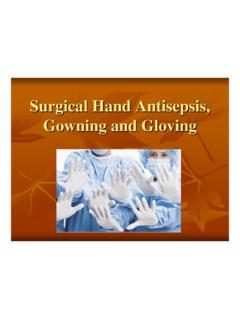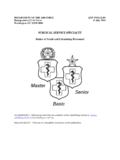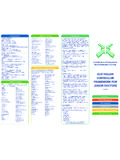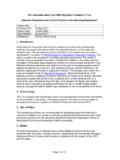Transcription of BBeesstt PPrraaccttiiccee PPrroottooccoollss Clinical ...
1 WHO/EHT/CPR 2004 reformatted. 2007 WHO surgical Care at the District Hospital 2003 Best Practice ProtocolsBBeessttPPrraaccttiicceePPrroot tooccoollss Clinical Procedures Safety LLLiiisssttt ooofff CCCooonnnttteeennntttsss 1. Ethics- Patient Consent 2. Record keeping 3. Operating Room ( ) 4. Hand Washing Techniques 5. Scrubbing and gowning 6. Prevention of Transmission of HIV 7. Infection Prevention and Universal Precautions 8. Waste disposal in Clinical procedures at resource limited health care facility 9. Diagnosis of Labour 10. Diagnosis of vaginal bleeding in early pregnancy 11. Severe Pre-Eclampsia and Eclampsia 12. Eclampsia Management 13. Urinary Retention: Emergency Drainage 14. Caesarean Section 15. Check List Prior to inducing anaesthesia 16. Managing unexpected effects of a spinal anaesthetic 17. Postoperative management 18.
2 Postoperative pain relief 19. Cardiac life support 20. Airway Management 21. surgical Cricothyroidotomy 22. Cast Application 23. Splint application 24. Caring for a cast or splint 25. Removing a cast 26. Hand lacerations 27. Disaster Planning 28. Trauma Team Leader Responsibilities 29. Abdominal Trauma 30. Burns Management: adults and children 31. War-related Trauma 32. Transportation of critically ill patients Clinical Procedures Unit Department of Essential Health TechnologiesWorld Health Organization, 20 Avenue Appia, 1211, Geneva 27, Switzerland Fax: 41 22 791 4836 Internet: WHO/EHT/CPR 2004 reformatted. 2007 WHO surgical Care at the District Hospital 2003 EEEttthhhiiicccsss--- PPPaaatttiiieeennnttt CCCooonnnssseeennnttt Before performing a procedure, it is important to receive consent from the patient: - Ask permission to make an examination - Explain what you intend to do before doing it - Ask the patient if he/she has questions & answer them - Check that the patient has understood - Obtain permission to proceed - Be mindful of the comfort and privacy of others.
3 With invasive and surgical procedures, it is particularly important to give a full explanation of what you are proposing, your reasons for wishing to undertake the procedure and what you hope to find or accomplish. Ensure that you use language that can be understood; draw pictures and use an interpreter, if necessary. Allow the patient and family members to ask questions and to think about what you have said. It may be necessary to consult with a family member or community elder who may not be (continued to next page) WHO/EHT/CPR 2004 reformatted. 2007 WHO surgical Care at the District Hospital 2003 EEEttthhhiiicccsss--- PPPaaatttiiieeennnttt CCCooonnnssseeennnttt cccooonnntttiiinnnuuueeeddd present; allow for this if the patient s condition permits. If a person is too ill to give consent (for example, if unconscious) and their condition will not allow further delay, you should proceed, without formal consent, acting in the best interest of the patient.
4 Record your reasoning and plan. Informed consent means that the patient and the patient s family understand what is to take place, including the potential risks and complications of both proceeding and not proceeding, and have given permission for a course of action. Be attentive to legal, religious, cultural, linguistic and family norms and differences. Some hospitals require patients to sign a document indicating that the surgical procedure and potential complications have been explained and that permission to proceed has been granted. (continued to next page) WHO/EHT/CPR 2004 reformatted. 2007 WHO surgical Care at the District Hospital 2003 EEEttthhhiiicccsss--- PPPaaatttiiieeennnttt CCCooonnnssseeennnttt cccooonnntttiiinnnuuueeeddd This paper is then included in the patient s record. If this is not a formal requirement in your hospital, document the conversation in which consent was given and include the names of people present at the discussion.
5 Informed consent means that the patient and the patient s family understand what is to take place, including the potential risks and complications of both proceeding and not proceeding, and have given permission for a course of action. It should be a choice made free from coercion. Our duty as professionals to provide service and care can come into conflict with our personal opinions. It is important to be aware of these feelings when they occur and to understand where they are coming from. If we are asked to care for someone who is alleged to have committed a crime, it is not our responsibility to administer justice. (continued to next page) WHO/EHT/CPR 2004 reformatted. 2007 WHO surgical Care at the District Hospital 2003 EEEttthhhiiicccsss--- PPPaaatttiiieeennnttt CCCooonnnssseeennnttt cccooonnntttiiinnnuuueeeddd However, it is our responsibility to provide care.
6 This can be difficult, but it is important to recognize that: - Our job is not to judge, but to provide care to all without regard to social status or any other considerations. - By acting in this way, we will be seen to be fair and equitable by the community we serve. WHO/EHT/CPR 2004 reformatted. 2007 WHO surgical Care at the District Hospital 2003 Record Keeping Admission note/preoperative note Operating room records usually includes: - Patient identity - Procedure performed - Persons involved - Complications. Delivery book The operative note Postoperative notes can be organized in the SOAP format: Subjective How the patient feels Objective Findings on physical examination, vital signs and laboratory results Assessment What the practitioner thinks Plan Management plan; this may also include directives which can be written in a specific location as orders . Discharge note: record: - Admitting and definitive diagnoses - Summary of patient s course in hospital - Instructions about further management as an outpatient, including any medication and the length of administration and planned follow-up.
7 WHO/EHT/CPR 2004 reformatted. 2007 WHO surgical Care at the District Hospital 2003 HHHaaannnddd WWWaaassshhhiiinnnggg TTTeeeccchhhnnniiiqqquuueeesss When scrubbing (Figure ): - Remove all jewellery and trim the nails - Use soap, a brush (on the nails and finger tips) and running water to clean thoroughly around and underneath the nails - Scrub your hands and arms up to the elbows - After scrubbing, hold up your arms to allow water to drip off your elbows - Turn off the tap with your elbow. After scrubbing your hands: (continued to next page) WHO/EHT/CPR 2004 reformatted. 2007 WHO surgical Care at the District Hospital 2003 - Dry them with a sterile towel and make sure the towel does not become contaminated. - Hold your hands and forearms away from your body and higher than your elbows until you put on a sterile gown and sterile gloves.
8 Always wash your hands after removing your gloves WHO/EHT/CPR 2004 reformatted. 2007 WHO surgical Care at the District Hospital 2003 Scrubbing and gowning Before each operation, all members of the surgical team that is, those who will touch the sterile surgical field, surgical instruments or the wound should scrub their hands and arms to the elbows. Scrubbing cannot completely sterilize the skin, but will decrease the bacterial load and risk of wound contamination from the hands. Every hospital should develop a written procedure for scrubbing that specifies the length and type of scrub to be undertaken. It is usual that the first scrub of the day is longer (minimum 5 minutes) than any subsequent scrubs between consecutive clean operations (minimum 3 minutes). surgical gloves prevent transmission of HIV through contact with blood, but there is always the possibility of accidental injury and of a glove being punctured.
9 Promptly change a glove punctured during an operation and rinse your hand with antiseptic or re-scrub if the glove has leaked during the puncture. WHO/EHT/CPR 2004 reformatted. 2007 WHO surgical Care at the District Hospital 2003 Patient safety is of primary concern; do not compromise it. Change your gloves only when it is safe for the patient WHO/EHT/CPR 2004 reformatted. 2007 WHO surgical Care at the District Hospital 2003 OOOpppeeerrraaatttiiinnnggg RRRoooooommm ((( ))) The operating theatre is a room specifically for use by the anaesthesia and surgical teams and must not be used for other purposes. Both rooms require: Good lighting and ventilation Dedicated equipment for procedures Equipment to monitor patients, as required for the procedure Drugs and other consumables for routine and emergency use. Ensure that procedures are established for the correct use of the and all staff is trained to follow them: Keep all doors to the closed, except as needed for the passage of equipment, personnel and the patient Store some sutures and extra equipment in the to decrease the need for people to enter and leave the during a case Keep to a minimum the number of people allowed to enter the , especially after an operation has started Keep uncluttered and easy to clean WHO/EHT/CPR 2004 reformatted.
10 2007 WHO surgical Care at the District Hospital 2003 Between cases, clean and disinfect the table and instrument surfaces At the end of each day, clean the : start at the top and continue to the floor, including all furniture, overhead equipment and lights, use a liquid disinfectant at a dilution recommended by the manufacturer Sterilize all surgical instruments and supplies after use and store them protected and ready for the next use Leave the ready for use in case of emergency. WHO/EHT/CPR 2004 reformatted. 2007 WHO surgical Care at the District Hospital 2003 PPPrrreeevvveeennntttiiiooonnn ooofff TTTrrraaannnsssmmmiiissssssiiiooonnn ooofff HHHIIIVVV Take care of your patients, your co-workers and yourself: Do not recap needles Set up sharps containers in the places where you use sharps; the further you have to move to dispose of a sharp the greater the chance of an accident Do not use the same injection set on more than one patient Dispose of your own sharps Pass needles, scalpels and scissors with care and consideration.













